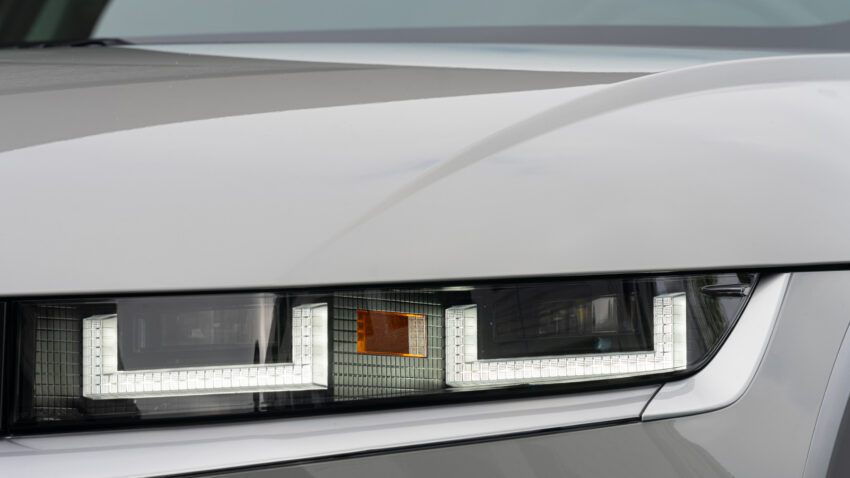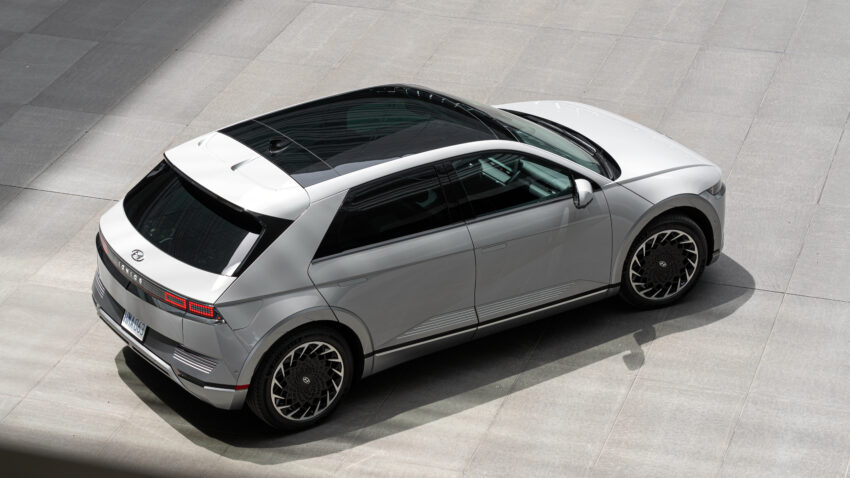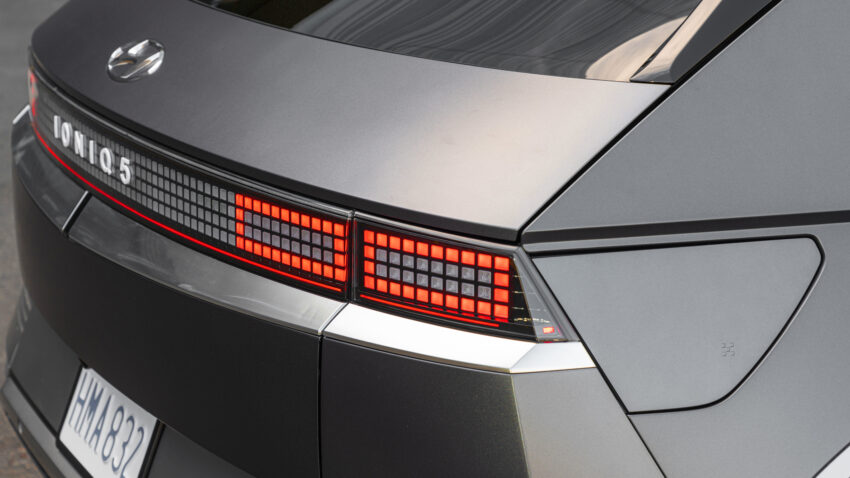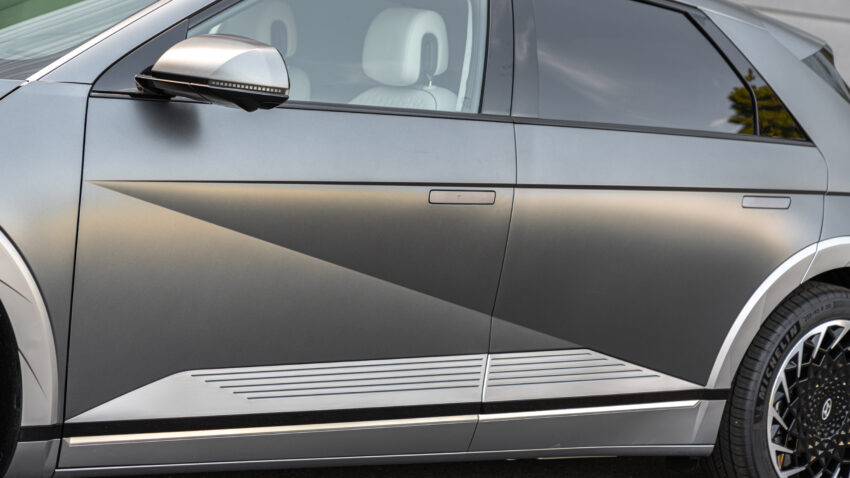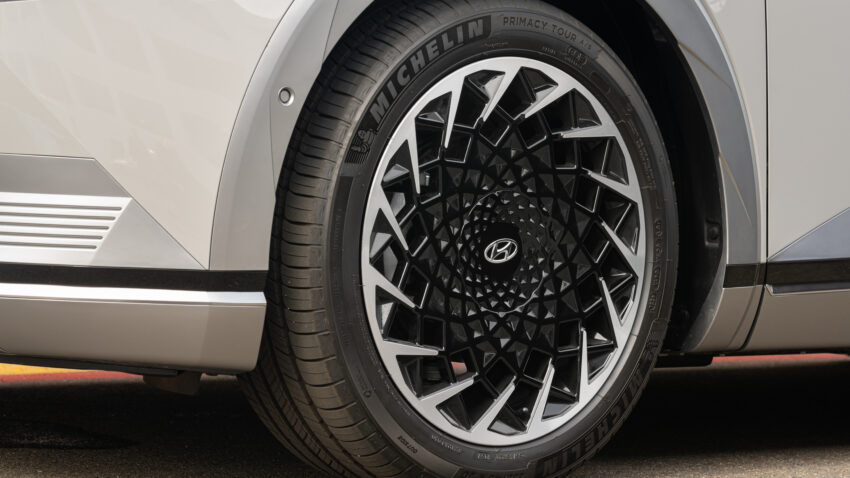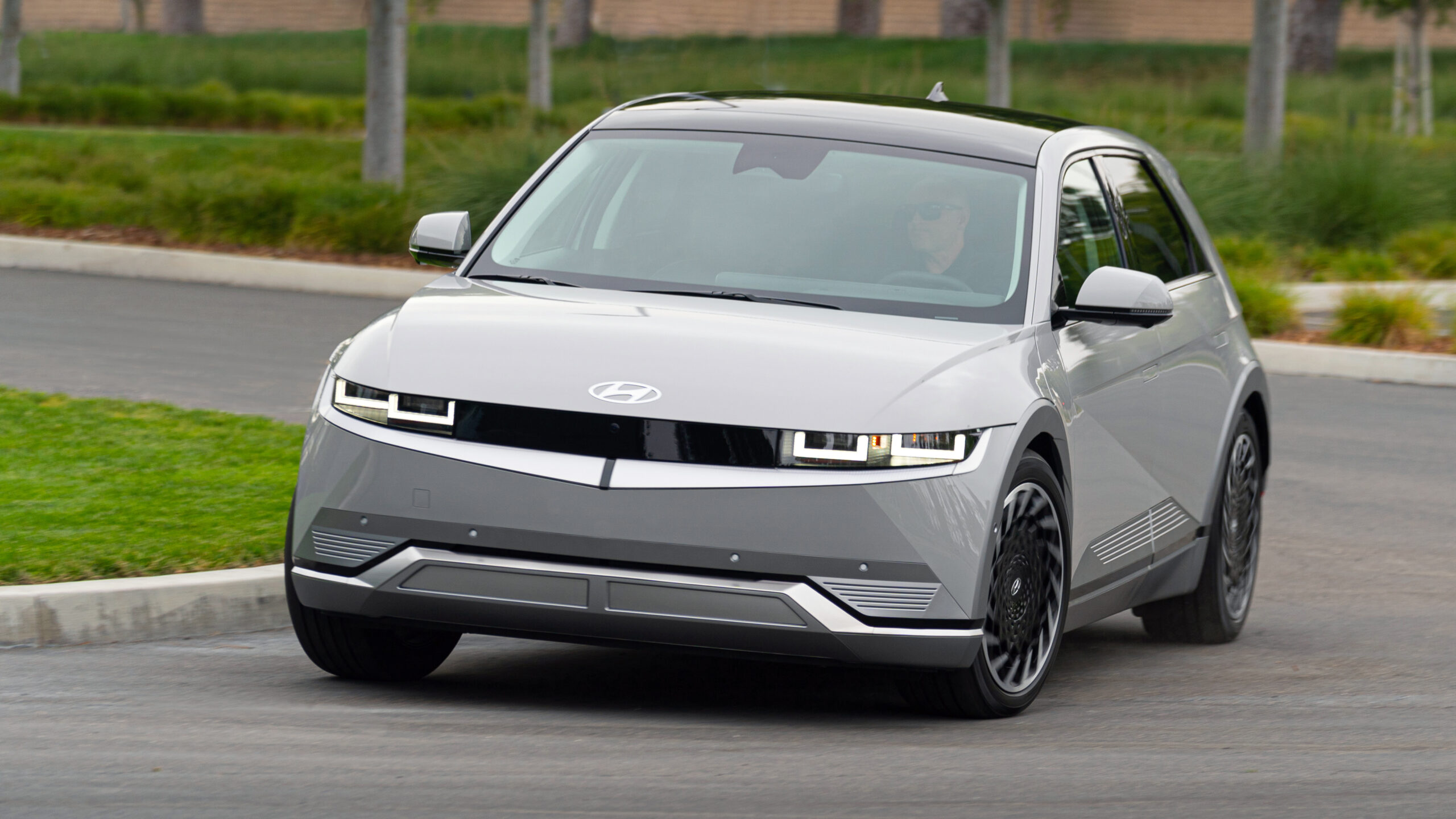
When Hyundai revealed the Asian and European version of its new Ioniq 5 compact electric crossover, we said that if its real-world performance and build quality matched its looks and specs it ought to ensure Hyundai a place in the top ranks of electric vehicle shoppers’ most-wanted lists. The just-revealed U.S. version reinforces that.
The first model in Hyundai’s new Ioniq sub-brand for electric vehicles, the Ioniq 5 has modern good looks, a roomy and well-planned interior, tons of features, lots of power and a decent amount of cargo capacity and towing capability.
[A 7-min., 30-sec. read.]
It continues an electrification drive that already this year has seen a refreshed Kona EV and two new hybrid variants of the popular Santa Fe crossover. In all, Hyundai and its corporate sibling Kia Motors have vowed to bring 23 new EVs to market globally by 2025.
The Ioniq 5 is scheduled to hit U.S. shores sometime this fall after summertime launches in Europe and South Korea.
Pricing hasn’t been announced – that will come closer to the on-sale date. But Hyundai typically is quite price competitive. We expect the Ioniq 5 to start somewhere around $45,000 before any federal, state or local incentives.
For a time, at least, Hyundai will be selling the 2022 Ioniq 5 alongside the Hyundai Kona EV small crossover – there are no plans to rebrand the Kona as an Ioniq. But there are two more Ioniq models coming soon, a sporty sedan, the Ioniq 6, in 2022, and the Ioniq 7 large SUV in 2024.
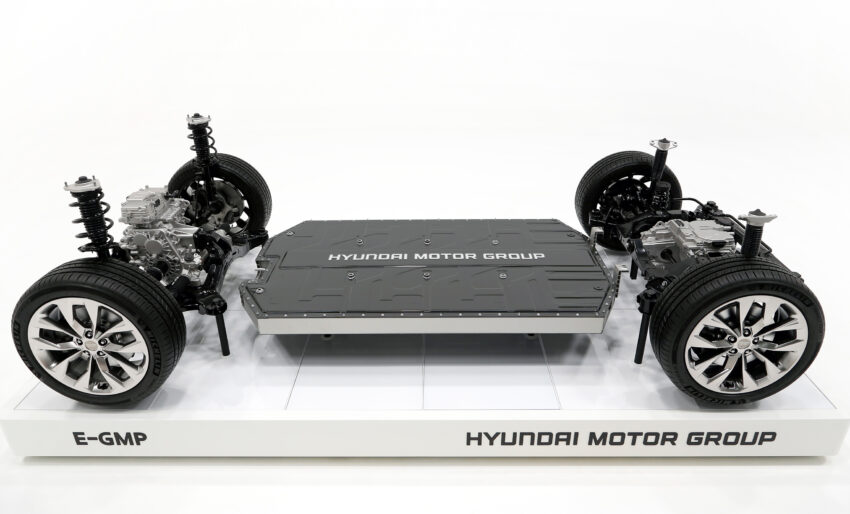
They all will use Hyundai’s new modular EV platform – one designed specifically to house batteries and electric motors. It will allow for a variety of motor and battery combinations and a variety of body types. And because the Ioniq vehicles will be built on an EV-specific platform, they should deliver far better ride and handling, along with a lot more room, than EVs whose unique components are forced into a [platform originally designed for an internal combustion powertrain.
Ioniq 5 Trims
Hyundai will market the Ioniq 5 in the U.S. in three trim levels. Neither pricing nor a full list of features hasn’t been released, but the automaker has shared some details.
The base SEL will come with all-LED lighting, 19-inch alloys, a 12.3-inch instrument display and a 12.3-inch infotainment touchscreen, Hyundai’s full-range DC fast charging capability – it switches automatically between 400 volts and 800 volts depending on the fast charge station’s capacity -and the car maker’s SmartSenseSafety suit of advanced safety and driver assistance systems.
The SEL adds automatic flush door handles, faux leather (we used to call it vinyl) upholstery, a hands-free power liftgate and Hyundai’s Highway Drive Assist 2 system, which permits limited hands-free driving on more than 10,000 miles of U.S. highways that have been screened for lane and side markers that can be easily read by the system’s scanners.
With the Limited trim, buyers get a panoramic glass roof, 20-inch alloys, a Bose audio system, an augmented reality head-up system, remote parking assist, eclining front seats with leg rests, and a blind-view monitor and surround-view camera system.
Batteries and Range
The Ioniq 5 will have two battery options – a standard 58 kWh pack and a long-range 77.4 kWh pack, but only the larger battery will be offered in the U.S., where the general rule of thumb for battery pack size is that more is better. The batteries will be stowed in a flat package beneath the floor and between the axles.
Hyundai hasn’ received official EPA range and fuel efficiency estimates for the U.S. version of the Ioniq 5, but the company;s own estimates place range for rear-wheel drive versions at 300 miles and for all-wheel drive versions at 269 miles for the SE and SEL trims and 244 miles for the Limited, which has a glass roof and other standard features that boost its weight.
Charging Time
The Ioniq 5’s standard 240-volt, Level 2 system for home, workplace and opportunity charging (there are a lot of Level 2 chargers installed at malls, theaters, restaurants and such) is rated at 10.9 kilowatts, sufficient to replenish a 90 percent depleted battery in just under seven hours.
All trim levels will have what Hyundai describes as “ultra-fast” DC quick-charge capability at up to 350 kilowatts on 400- to 800-volt chargers, which are rare now but are being installed along major routes to help satisfy consumer demand for hassle-free EV travel.
An 800-volt DC charger could take the standard range Ioniq 5 battery to 80 percent capacity from 10 percent in under 20 minutes – adding 68 miles of range every 5 minutes.
Ioniq 5 owners will get two years of unlimited 30-minute charging sessions at no cost on Electrify America’s nationwide network of more than 600 DC quick-charging stations.
Hey, Good Lookin’
The Ioniq 5 has a wheelbase that’s 4 inches longer than the full-size Palisade SUV’s, yet the overall body length is 14 inches shorter than the Palisade’s. Inside, that means more room for people and cargo. And because there’s no mechanical drive shaft, the Ioniq 5’s floor is flat.
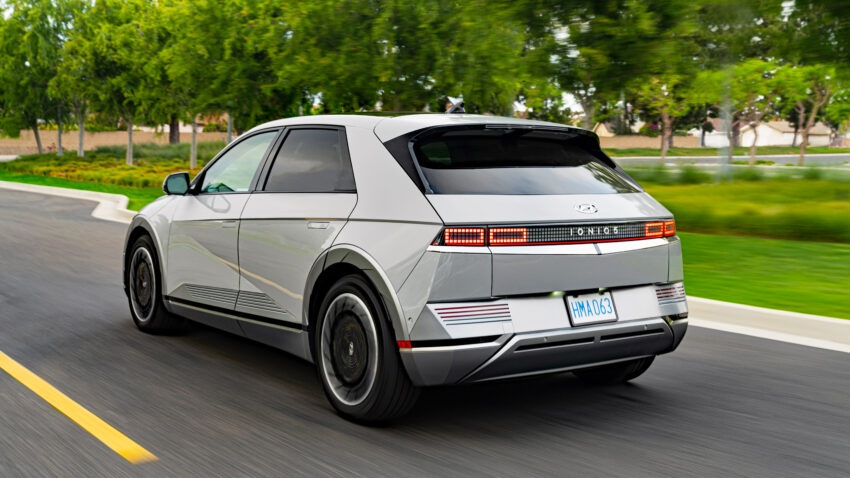
That allows for sliding seats and a sliding center console to facilitate easy rear-seat ingress and egress; it also enabled designers to deliver the interior space of a full-size sedan in a vehicle with a mid-size crossover’s exterior.
That exterior features a refreshingly different design. The 2022 Ioniq 5 isn’t a boxy, SUV-like crossover, nor does it insult crossover shoppers with a sedan-like roofline that eliminates a lot of cargo-carrying utility.
Instead, Hyundai’s design shop decided to pay homage to the past with the first EV from the automaker’s forward-looking Ioniq marque, giving the Ioniq 5 a silhouette that evokes the original Hyundai Pony car of the early 1970s.
The Ioniq 5’s stance is mildly aggressive – with the rear leaning forward and hiked up just a bit, like a sprinter straining in the starting blocks.
The flat roof slopes slightly toward the rear, the sides would be slabs were it not for sharp crease in the door panels that accentuate the forward lean.
Hyundai’s first clamshell hood covers a small storage area where an engine would be if the Ioniq 5 were a gasoline burner. The hood’s leading edge shields the rectangular LED headlights like the visor on a cap. There’s no grille, and the front bumper is integrated into the fascia, not handing out front like an afterthought. Oddly, Hyundai located the charge port on the Ioniq 5’s right rear flank, requiring drivers to either back up to get near a charging station or to stretch the station’s cable the length of the car when nosed-in.
The rear fascia repeats the design elements of the front, including the integrated bumper.
Overhangs front and rear are minimal and the wheel arches are well-filled with 20-inch alloys – a combination that gives the Ioniq 5 a subtly powerful look.
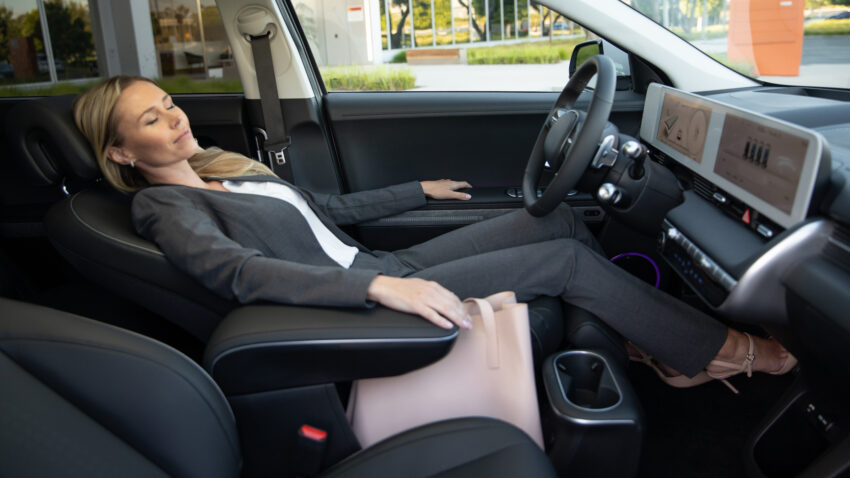
The floors are flat, the front buckets have extended leg rests to help drivers and passengers get comfortable during battery recharging sessions during road trips. The front seats slide up and back, as does the center console, to create more space for people to get in and out of the rear seating area and, in the case of the console, to give rear seat passengers easier access to cup holders, wireless phone charging and storage.
The rear seats also slide. They can be moved forward up to 5.3 inches to create more storage room when not needed for passengers.
Inside, there’s a minimalist dash with a pair of 12.3-inch screens – a driver information center directly behind the flat-bottom steering wheel and a center-mounted infotainment touchscreen that floats above a panel containing real knobs and switches for the Ioniq 5’s audio and climate control systems.
Most interior surfaces are made of material derived from recycled plastics and covered with fabrics woven form natural wool and plant-based yarns. Available leather seats are tanned and dyed with eco-friendly solutions.
The Ioniq 5 will be the first Hyundai with over-the-air updates for navigation maps and multimedia software.
It also will offer an “in-car payment” system that’s still under development. It is being designed to use the Ioniq 5’s infotainment screen to enable owners to use a credit card to make payments for things like battery charging, parking fees and even on-line purchases of fast-food.
Ioniq 5 Power
The 2022 Ioniq 5’s muscular looks aren’t deceiving.
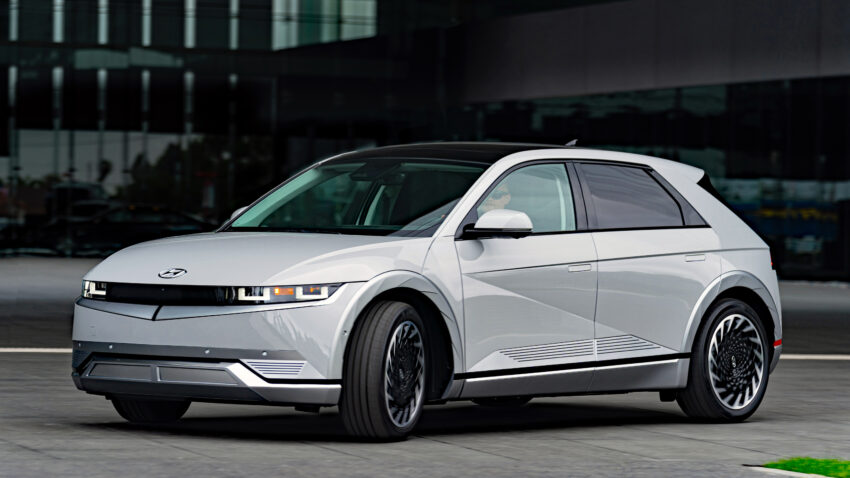
The rear-wheel drive version with the 77.4-kWh battery pack is rated by Hyundai at 225 horsepower and 258 pound-feet of torque. With all-wheel drive, which adds a second electric motor to drive the front wheels, that jumps to 320 horsepower and 446 pound-feet.
Hyundai says the AWD package will deliver an elapsed time of 5.2 seconds in a 0-62 mph sprint,.
And More Power
The Ioniq 5 also will be equipped with a pair of 120-volt power outlets, one inside the car in the rear seating area, the other outside, in an adapter that plugs into the vehicle’s charging port.
Hyundai calls it V2L, the “vehicle to load” feature. It uses some of the battery’s power to run 120-volt appliances such as electric tools, outdoor lights, external audio equipment, even electric skillets and toaster ovens at the camp site or during a power outage at home.
Making Driving Safer and Easier
The Ioniq 5 gets all the latest in Hyundai’s arsenal of driver assistance and safety features, including – for the Limited trim – the automaker’s first application of its augmented reality head-up display. It projects information including speed limits, navigation directors, road signs and upcoming obstacles onto a real-time, eye-level view of the road.
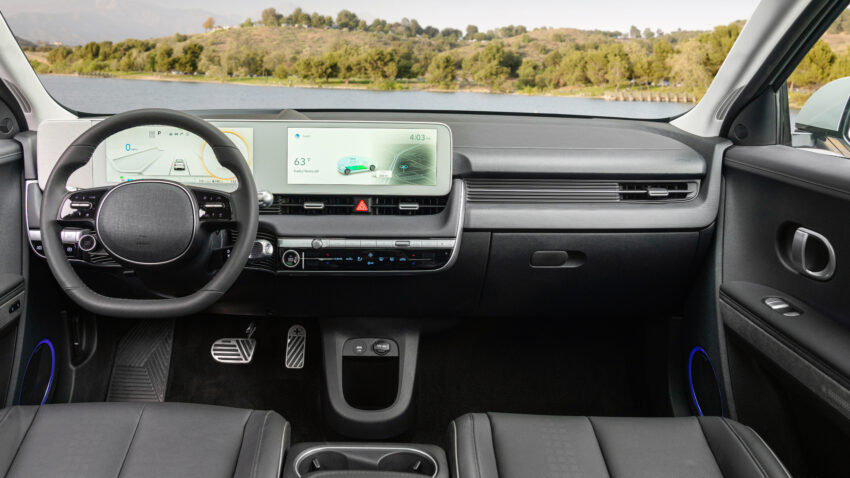
The new EV also will be the first to use Hyundai’s Highway Assist 2 system, which keeps the car centered and following a vehicle ahead, with full stop-and-go ability and some automated lane and road changing capability. It is not, however, a hands-free system and isn’t available on the base SE trim.
Safety and assistance features that are standard on all trims include include forward collision warning and pedestrian detection with emergency braking; rear cross-traffic and parking collision avoidance with emergency braking; a diver inattention warning system; automatic high beams; speed limit warning and a safe exit assist that keeps the rear doors locked when the car is parked but oncoming traffic is detected. The forward collision system also works at intersections and road junctions, detecting oncoming traffic – including pedestrian and cyclists – and automatically braking if necessary during left turns and alerting and reacting to traffic coming from either side of a cross-street while the vehicle is crossing an intersection.
Cargo
Getting rid of the gas engine makes room, and for the Ioniq 5 that means a smallish 0.8 cubic foot cargo space under the hood – an area popularized by Tesla as the “frunk,” or front trunk.
The cargo hold behind the rear seats measure 27.2 cubic feet, which is competitive but at the bottom of the class. Total cargo area exclusive of the frunk expands to 59.3 cubic feet when the rear seat backs are folded down, just shy of the Mustang Mach-E’s 59.6 cubic feet and the Volkswagen ID.4’s 60.2 cubes but enough for the contents of about 20 carry-on airline bags or the take from a blow-out shopping trip to a big-box retailer.
For hauling even more, the Ioniq 5 is tow-rated at 1,500 pounds.
Tough Competition
Hyundai’s original Pony didn’t do well, but the automaker has come a long way since then.
The Ioniq 5 will have to duke it out with competitors that include the VW ID4, some versions of Ford’s Mustang Mach-E and even corporate stablemate Kia’s upcoming Kia EV6, which shares the same platform and many of the same features. Upcoming competition also includes Nissan’s Ariya. While the Tesla Model Y is in the same segment, Hyundai considers it a premium vehicle – at least price-wise – and not a direct competitor to the Ioniq 5.
The growing set of players in the mid-size electric crossover segment promises to give consumers a lot to choose from, and Hyundai’s entry appears quite capable of holding its own.

Categories Electric Vehicles, News Tags 2022 Ioniq 5, Vs, Hyundai ioniq 5

